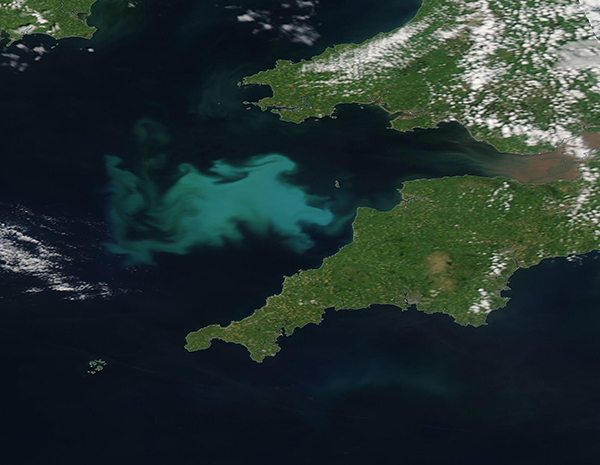Images
June 3, 2022 - Phytoplankton Bloom off of England and Wales
Tweet
A swirl of milky blue in Bristol Channel marked a bloom of phytoplankton in late May 2022. The Moderate Resolution Imaging Spectroradiometer (MODIS) on board NASA’s Aqua satellite acquired this true-color image on May 28.
The Bristol Channel is the largest natural inlet in the United Kingdom, stretching between the Atlantic Ocean and the River Severn and separating South Wales (north) from the counties of Somerset and Devon, England (south). Seven rivers carry fresh water, along with sediment and nutrients, into the River Severn Estuary at the eastern-most end of the channel. The nutrients spilled into the Bristol Channel from these rivers can help spur the growth of phytoplankton. The tan color of the sediment-filled waters near the River Severn Estuary can be easily seen in the image.
Phytoplankton are microscopic plant-like organisms that live in these waters year-round. When conditions are right—favorable water temperatures, enough nutrients, and adequate sunlight—these organisms can reproduce explosively, creating huge blooms that can be easily seen from space. They are an important part of the marine food web, forming the base that helps feed the diverse and rich fishery found in the Bristol Channel. Some fishes of commercial or recreational importance found in these waters include pollock, whiting, bass and eels. Several species of porpoise, dolphin and shark live in the Channel, along with grey seals, crab, and cockles.
Image Facts
Satellite:
Aqua
Date Acquired: 5/28/2022
Resolutions:
1km (131 KB), 500m (314.7 KB), 250m (685.8 KB)
Bands Used: 1,4,3
Image Credit:
MODIS Land Rapid Response Team, NASA GSFC
Tweet
A swirl of milky blue in Bristol Channel marked a bloom of phytoplankton in late May 2022. The Moderate Resolution Imaging Spectroradiometer (MODIS) on board NASA’s Aqua satellite acquired this true-color image on May 28.
The Bristol Channel is the largest natural inlet in the United Kingdom, stretching between the Atlantic Ocean and the River Severn and separating South Wales (north) from the counties of Somerset and Devon, England (south). Seven rivers carry fresh water, along with sediment and nutrients, into the River Severn Estuary at the eastern-most end of the channel. The nutrients spilled into the Bristol Channel from these rivers can help spur the growth of phytoplankton. The tan color of the sediment-filled waters near the River Severn Estuary can be easily seen in the image.
Phytoplankton are microscopic plant-like organisms that live in these waters year-round. When conditions are right—favorable water temperatures, enough nutrients, and adequate sunlight—these organisms can reproduce explosively, creating huge blooms that can be easily seen from space. They are an important part of the marine food web, forming the base that helps feed the diverse and rich fishery found in the Bristol Channel. Some fishes of commercial or recreational importance found in these waters include pollock, whiting, bass and eels. Several species of porpoise, dolphin and shark live in the Channel, along with grey seals, crab, and cockles.
Image Facts
Satellite:
Aqua
Date Acquired: 5/28/2022
Resolutions:
1km (131 KB), 500m (314.7 KB), 250m (685.8 KB)
Bands Used: 1,4,3
Image Credit:
MODIS Land Rapid Response Team, NASA GSFC




